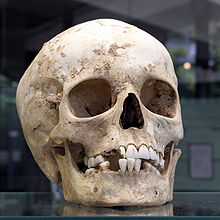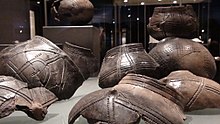Herxheim mine
The uncovered finds from the mine in Herxheim near Landau / Pfalz changed the scientific basis for discussion about the linear ceramic culture . The municipality of Herxheim bei Landau / Pfalz is located in the Südliche Weinstraße district .
description
In 1995 a site was designated for a new industrial park west. Since archaeological finds had been exposed more frequently in this area, the Directorate for State Archeology was commissioned to begin extensive archaeological excavations before construction began. Due to the available finds and the results, the excavations were continued in 2005/06. The evaluations and investigations continue.

During the first excavations between 1996 and 1999, the remains of a Neolithic settlement of linear ceramicists were found. The excavations in Herxheim were under the direction of Andrea Zeeb-Lanz from the State Archeology of Rhineland-Palatinate and continued until 2011. In 2001 the excavation began on a courtyard in the immediate vicinity of the mine.
The settlement existed from the older band ceramics (Flomborn phase) to the youngest band ceramics, around 5300-5150 BC. Chr.
To the south of it, a large number of pits were found that were so close together and overlapping that at first the impression of two ditches running around the village was created. This trench system was later recognized as an earthwork .
A find in Herxheim changed the idea of the ceramic earthworks . The exposure of the individual layers of earth in this mine has so far yielded the remains of at least 450 human skeletons, deposited animal bones and deliberately destroyed objects such as grinding stones and pottery . The high number of skeletal parts is atypical for a single settlement.
Finds and excavation results
In the pits that can be assigned to the youngest section, there was a multitude of human bones, many of them smashed, almost always loosened from the anatomical association. The number of at least 450 skulls (if the excavation of the mine has not yet been completed) proves that many more people were buried in Herxheim than could have lived there during the most recent phase of the ceramic band. Numerous other finds were also found in the pits, such as pottery , flint or millstones, many of which were also deliberately destroyed.

The bones found near Herxheim show traces of targeted cuts. Flat, narrow cuts on the skullcap indicate scalping of the affected individuals, traces on other human bones on skinning , severing of tendons as in amputations as well as decarnation (defecation). The traces appear comparable to those on the bones of slaughtered animals. Often the bones are crushed and the muscle meat scraped off. After examining the bones that had been cleaned of sintered lime and the cutting marks on them, Bruno Boulestin , an anthropologist from the University of Bordeaux , interpreted the bones as the remains of cannibal meals. Analyzes of the collagen contained in the bones also clearly indicate that this was heated by boiling and partially destroyed in the process. Likewise, scorch marks on some skulls are interpreted to mean that these skulls were damaged by brief exposure to heat of fire. Discoloration typical of burns could only be found on the front teeth, but not on the molars. The scientists involved in the study pointed out that traces of this kind always occur when a person's lips roll up from being burned and expose their front teeth, while the molars are usually better protected from the effects of fire by the thicker muscle flesh of the cheeks.
The archaeologists reconstructed that the deceased were only buried in this way for about 50 years. The events can be traced back to the end of the epoch of the band ceramics, i.e. between about 5000 and 4950 BC. - that is, the time in which the massacre of Schletz ( Lower Austria ), the massacre of Talheim ( Baden-Württemberg ) and the massacre of Kilianstädten ( Hesse ) took place.
In the case of bone finds in which smaller bones such. If, for example, the hand and tarsal bones are almost completely missing, it is perhaps a (not uncontested) second burial by band ceramists from large parts of Europe. Ceramic finds indicate connections to the Paris Basin , the Moselle region , Belgium, Saarland , Central Germany and Bohemia . Pottery shards with ribbon patterns were found, as they were common in these far away settlement areas. This could indicate that Herxheim was a central cult site for European linear ceramics. Perhaps the dead who had already been buried in their homeland were brought here to be buried again at this place of worship. Archaeologists suspect a death ritual, which is also indicated by various damage to the skeletons.
The investigation of the isotopes of strontium -87 and strontium-86 in the tooth enamel of 54 individuals showed that they came from granite-rich mountainous areas, i.e. they were not banded ceramists who only settled and planted their fields on loess-rich valley plains.
See also
Web links
- DFG project “Herxheim b. Landau "
- Mine works as a mass grave - Herxheim
- Markus Tremmel: The Herxheim project. "The grave pits of the dismembered corpses". In: Bavarian Archeology. Issue 6, 2/2008
- Florian Stark: Hundreds were killed, cut up and fleshed out in Welt Online on September 15, 2019
- Andrea Zeeb-Lanz : Herxheim - a ritual center of ribbon ceramics with human sacrifice and high potential for destruction. On the (preliminary) final results of the scientific evaluation of the exceptional site in Herxheim near Landau. Published on February 17, 2020 ( archaeologie-online.de )
literature
- Fabian Haack: The early Neolithic moat in Herxheim near Landau: architecture, backfilling processes and service life. Dissertation at Freie Universität Berlin, Berlin 2014 ( fu-berlin.de ).
- Alisa Hujić: Paleodontological investigations on skeletal remains of the ceramic band mine in Herxheim near Landau / Pfalz. Master's thesis, Eberhard Karls University of Tübingen, February 2009 ( fu-berlin.de ).
- Andrea Zeeb-Lanz (Ed.): Crises - Cultural Change - Continuities. At the end of ribbon ceramics in Central Europe. Contributions from the international conference in Herxheim near Landau (Palatinate) from 14. – 17. 06. 2007. Marie Leidorf, Rahden / Westphalia 2009, ISBN 978-3-89646-440-8 .
- therein pp. 61–77: Christian Jeunesse, Philippe Lefranc, Samuel van Willigen: The Palatine ceramics: definition and periodization of a new regional group of linear ceramics. ( academia.edu ).
- Andrea Zeeb-Lanz (Ed.): Ritualized Destruction in the Early Neolithic - The Exceptional Site of Herxheim (Palatinate, Germany) (= Research on Palatinate Archeology Volume 8.1), Speyer 2016, ISBN 978-3-936113-09-9 .
- Rouven Turck: To prove mobility in the Neolithic: Isotope analyzes of human individuals from the most recent ceramic findings from the Herxheim mine near Landau (Palatinate). Dissertation, University of Heidelberg 2012 ( [1] online archiv.ub.uni-heidelberg.de)
Individual evidence
- ↑ Angelika Franz: Excavation in the Palatinate: The human butcher from Herxheim . In: Spiegel Online . December 7, 2009.
- ↑ Jörg Orschiedt, Miriam N. Haidle: The human skeletal remains from Herxheim. In: Andrea Zeeb-Lanz (Ed.): Crises - Cultural Change - Continuities. At the end of the band ceramics in Central Europe (= International Archeology. Volume 10). Marie Leidorf publishing house, Rahden / Westf 2009, pp. 41–52.
- ↑ Bruno Boulestin, Andrea Zeeb-Lanz, Christian Jeunesse, Fabian Haack, Rose-Marie Arbogast & Anthony Denaire: Mass cannibalism in the Linear Pottery Culture at Herxheim (Palatinate, Germany) . In: Antiquity. Volume 83, Issue 322, December 1, 2009, pp. 968-982, doi: 10.1017 / S0003598X00099282 .
- ↑ Andrea Zeeb-Lanz, Bruno Boulestin: Complex 9 (excavation 2005–2008): New findings on human bones - ritual with cannibalistic practices? last changed October 5, 2012.
- ↑ Andrea Zeeb-Lanz: What happened 7000 years ago in Herxheim? Ritual cannibalism in the Palatinate. What happened in Herxheim 7000 years ago? In: Biology in Our Time . Volume 44, No. 3, June 2014, pp. 172–180, doi: 10.1002 / biuz.201410536 .
- ↑ Alisa Hujić: Paleodontological investigations on skeletal remains of the ceramic band mine in Herxheim near Landau / Pfalz. Master thesis. Eberhard Karls University, Tübingen 2009.
- ^ Hans Holzhaider : Archeology in Germany: ritual massacres - or cannibalism . In: Süddeutsche Zeitung . June 3, 2011.
Coordinates: 49 ° 8 '44.7 " N , 8 ° 11' 28.4" E

